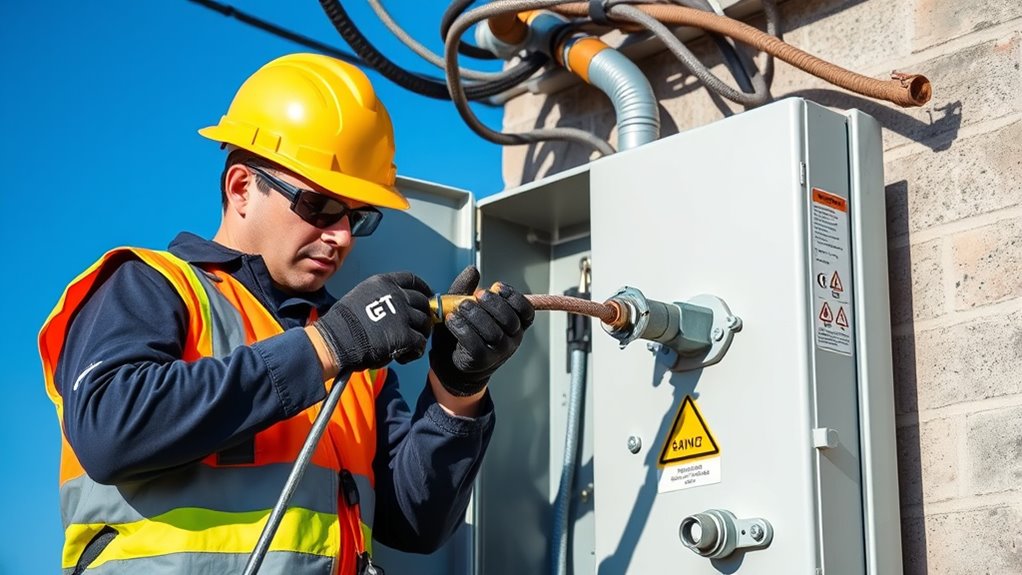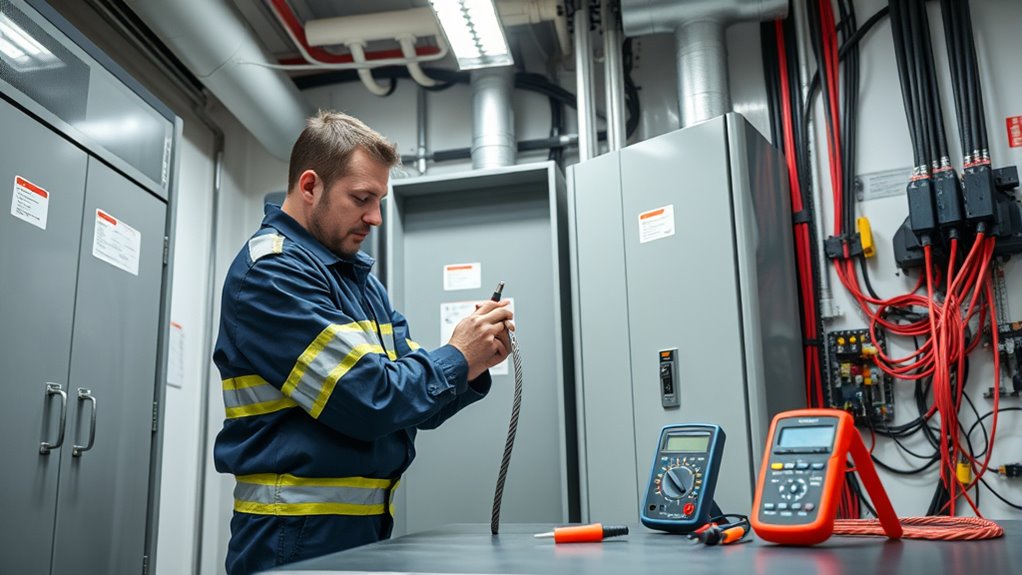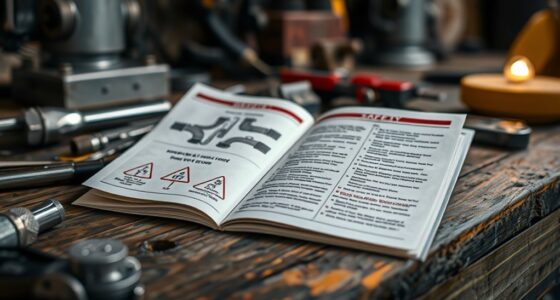To verify your service disconnects are safe and up to code, place them in accessible, visible spots near your utility meter, away from obstructions. Make sure the device is properly rated for your system’s load, and all grounding is correct. Follow safety standards and local regulations, and clearly label everything. Avoid common mistakes like incorrect labeling or placement issues, so your setup stays safe and reliable. Keep exploring to learn the full essentials for a compliant service disconnect.
Key Takeaways
- Ensure the disconnect is easily accessible, visible, and located near the utility meter or outside the home for quick emergency shutdown.
- Use a disconnect device rated for at least 125% of the continuous load to ensure safety and compliance.
- Follow local codes and NEC guidelines for proper placement, grounding, and installation of the disconnect.
- Clearly label all disconnects with durable, legible labels indicating purpose and voltage for quick identification.
- Regularly verify labels, inspect connections, and update documentation to prevent errors and maintain safety standards.
Understanding the Location and Accessibility of Service Disconnects

Where exactly are service disconnects located, and how accessible are they? Typically, you’ll find the service disconnect near your utility meter or on the exterior of your home. These disconnects are designed for easy access during emergencies or maintenance. It’s essential that they’re placed in a visible, unobstructed spot so you can quickly shut off power if needed. The emergency shutdown should be reachable without climbing or crawling, ensuring safety in urgent situations. Utility meters often have a built-in disconnect switch or are close to the main disconnect device. Proper placement guarantees you can quickly isolate your electrical system when required, whether for repairs or safety concerns. Ensuring the location of disconnects is well-marked and known to all household members can prevent delays during emergencies. Remember, accessibility isn’t just about convenience—it’s a vital safety measure.
Correct Sizing and Rating of Disconnect Devices

Choosing the correct size and rating for your disconnect device is essential to guarantee safety and proper functionality. An appropriately rated disconnect ensures effective overcurrent protection, preventing circuit damage or fires. Always match the disconnect’s ampere rating to the load it serves, and select a device rated for at least 125% of the continuous current, as per code requirements. Grounding requirements also play a fundamental role; ensure the disconnect is properly grounded to protect against electrical faults. Using a device with insufficient capacity risks tripping or failure, while an oversized disconnect may not provide adequate overcurrent protection. Proper sizing and rating help maintain system reliability, safety, and compliance with electrical standards. Always verify your selections with local codes and manufacturer specifications. Additionally, understanding dog names can be useful when selecting equipment with a friendly or approachable appearance to improve safety and user interaction.
Safety Standards and Code Compliance for Disconnect Installation

Proper installation of disconnect devices must comply with specific safety standards and electrical codes to guarantee reliable operation and protection. Utility regulations set the requirements for disconnect placement, grounding, and accessibility, ensuring safety during maintenance and emergencies. You should always follow the National Electrical Code (NEC) guidelines, which specify proper wiring methods and device ratings. Inspection procedures are critical to verify compliance; inspectors check that disconnects meet local safety standards, are properly rated, and are correctly installed according to code. Failing to meet these standards can lead to safety hazards, code violations, or electrical failures. Staying current with utility regulations and understanding inspection protocols guarantees your disconnect installation is safe, compliant, and reliable for ongoing service or repairs. Additionally, understanding bad lemon juice signs can help identify potential issues with electrical connections that may cause malfunction or hazards.
The Importance of Proper Labeling and Documentation

Clear labeling and thorough documentation are essential for guaranteeing safe and efficient service disconnects. Proper labeling best practices involve using clear, durable labels that stay legible over time, indicating the disconnect’s purpose and voltage. This helps everyone understand the system quickly, reducing risks during maintenance or emergencies. Documentation tips include keeping detailed records of disconnect locations, specifications, and recent inspections. Accurate documentation not only streamlines troubleshooting but also ensures compliance with safety standards. When labels are accurate and up-to-date, and records are complete, you minimize errors and delays. Proper labeling and documentation create a safer work environment, protect property, and help you meet regulatory requirements. Staying diligent in these areas benefits everyone involved and ensures smooth service disconnect operations. Additionally, understanding AI vulnerabilities can inform better safety protocols and reduce the risk of unforeseen issues during service procedures.
Common Mistakes and How to Avoid Them

One common mistake is neglecting to verify that labels are accurate and up-to-date, which can lead to confusion and safety hazards during service disconnects. To avoid this, you should always double-check labels before starting any work. Incorporate troubleshooting procedures to identify potential issues quickly and ensure everything is properly labeled. Follow maintenance best practices by regularly reviewing and updating disconnect labels, especially after repairs or upgrades. This helps prevent mistakes and keeps safety at the forefront. Remember these key points:
Always verify and update disconnect labels to ensure safety and prevent confusion during service work.
- Confirm labels match current circuit configurations
- Use clear, durable labels that won’t fade or peel
- Document any changes immediately for future reference
- Label accuracy is essential for safe and effective troubleshooting during service disconnects.
Sticking to these practices minimizes errors, enhances safety, and streamlines your troubleshooting process during service disconnects.
Frequently Asked Questions
How Often Should Service Disconnects Be Inspected or Maintained?
You should inspect your service disconnects at least once a year to guarantee safety and proper function. The maintenance frequency depends on the environment, with more frequent checks recommended in harsh conditions or if you notice any signs of wear or corrosion. Regular inspections help catch potential issues early, preventing outages or hazards. Always follow the manufacturer’s guidelines and local codes for specific inspection schedules and maintenance requirements.
Are There Specific Tools Required for Installing or Servicing Disconnects?
You need basic tools like screwdrivers, pliers, and a multimeter for installing or servicing disconnects. Make sure you have insulated tools for safety, and follow the installation procedures carefully to guarantee proper connections and compliance. Sometimes, specialized tools like a torque wrench or crimping tool are required for secure connections. Always double-check the manufacturer’s instructions to guarantee you’re using the right tools and following correct procedures for a safe, effective service.
Can I Upgrade My Disconnect Device Without Professional Help?
You can attempt DIY upgrades to your disconnect device, but you’ll need specific tool requirements like insulated screwdrivers, pliers, and possibly a voltage tester. However, working with electrical components is risky, and improper installation can cause hazards or code violations. It’s best to assess your skills honestly; if you’re unsure, hiring a professional ensures safety and compliance. Don’t risk damage or injury—know when to call in a licensed electrician.
What Are the Penalties for Non-Compliance With Disconnect Requirements?
If you ignore disconnection violations, penalties can hit hard. Penalty fines could stack up quickly, and authorities may require costly corrective actions. Imagine the stress of facing fines that drain your finances or risking service disconnection for non-compliance. Staying compliant isn’t just about following rules—it’s about avoiding these penalties altogether. Don’t gamble with disconnection violations; guarantee you meet all requirements to keep your service uninterrupted and fines at bay.
How Do Weather Conditions Affect the Placement of Service Disconnects?
Weather conditions substantially impact the placement considerations for your service disconnects. Extreme temperatures, heavy snow, or rain can cause corrosion or damage if disconnects aren’t properly protected or positioned. You should place them in sheltered, accessible locations that resist weather impact, ensuring safety and compliance. Proper placement minimizes weather-related issues, reducing maintenance needs and preventing outages caused by environmental factors. Always consider local climate when choosing disconnect locations.
Conclusion
By understanding these service disconnect essentials, you’ll avoid costly mistakes and keep everything running smoothly. Always pay attention to location, proper sizing, safety standards, and clear labeling—these are the building blocks of a safe setup. Remember, a stitch in time saves nine, so don’t cut corners now. When you follow the rules and double-check your work, you’ll be ahead of the game and make certain long-term safety and compliance.









